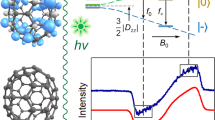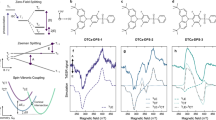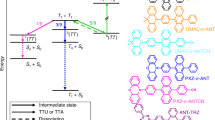Abstract
THE method of double electron–electron resonance (EDR) involves measurement of changes in the intensities of ESR lines, when one of them is saturated with microwave power. Similar phenomena (cross saturation) were observed previously (see refs. 1–3 and an unpublished paper by J. Hyde given at the Eighth International Symposium on Free Radicals, 1967). Bloembergen et al.4 explained this effect as a result of double transitions between different Zeeman levels in the absence of spin-lattice interactions. EDR is therefore a direct method for measurement of paramagnetic centre interactions. The simplest system in which EDR can be observed is that with three non-equidistant levels, for example, triplet centres with zero-field splitting.
This is a preview of subscription content, access via your institution
Access options
Subscribe to this journal
Receive 51 print issues and online access
$199.00 per year
only $3.90 per issue
Buy this article
- Purchase on Springer Link
- Instant access to full article PDF
Prices may be subject to local taxes which are calculated during checkout
Similar content being viewed by others
References
Giordmaine, G. A., Alsop, L. E., Noch, F. R., and Townes, C. H., Phys. Rev., 109, 302 (1958).
Moran, P., Phys. Rev., 135, 247A (1964).
Tanaka, S., Koma, A., and Kobaychi, M., J. Phys. Soc., Japan, 22, 127 (1967).
Bloembergen, N., Shapiro, S., Pershan, P., and Artman, J., Phys. Rev., 114, 445 (1959).
Chesnut, D. B., and Phillips, W. D., J. Chem. Phys., 35, 1002 (1961).
Jones, M. T., and Chesnut, D. B., J. Chem. Phys., 38, 1311 (1963).
Jones, M. T., J. Chem. Phys., 40, 1837 (1964).
Blumenfeld, L. A., Benderskii, V. A., Lubchenko, L. S., and Stunzas, P. A., Zournal Structurnoy Chimii (J. Struct. Chem.), 8, 829 (1967) (in Russian).
Blumenfeld, L. A., Goldanskii, V. I., Podgorezkii, M. I., and Tchernavskii, D. S., Zournal Structurnoy Chimii (J. Struct. Chem.), 8, 854 (1967) (in Russian).
Author information
Authors and Affiliations
Rights and permissions
About this article
Cite this article
BENDERSKII, V., BLUMENFELD, L., STUNZAS, P. et al. Double Electron–Electron Resonance of Triplet Excitons in Ion-radical Salts. Nature 220, 365–367 (1968). https://doi.org/10.1038/220365a0
Received:
Published:
Issue Date:
DOI: https://doi.org/10.1038/220365a0
This article is cited by
-
EPR in the USSR: the thorny path from birth to biological and chemical applications
Photosynthesis Research (2017)
-
Jim Hyde and the ENDOR Connection: A Personal Account
Applied Magnetic Resonance (2017)
Comments
By submitting a comment you agree to abide by our Terms and Community Guidelines. If you find something abusive or that does not comply with our terms or guidelines please flag it as inappropriate.



